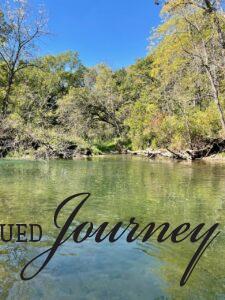Last Updated on December 4, 2025 by Rachel
Less is more! Find practical tidbits on how underconsumption can transform your life (and the planet).
As the trend of minimalism continues to rise, “less is more” is becoming a popular mantra. However, there is a step further we can take towards sustainability and conscious living… one that not only benefits our individual well-being but also has a significant and positive impact on the environment. This is where underconsumption comes in! If you are left with many questions, don’t worry! I’ll explain it all. Join me below for more!
Living Well with Less Through Sustainable Practices
In this post, we will explore the benefits and strategies of embracing underconsumption and how it can positively contribute to both our personal and global well-being. So, let’s shift our focus from “less is more” to “less is enough” and discover the power of underconsumption!
Shop Sustainable Home Products
The Power of Underconsumption: Find Freedom and a Richer Life Beyond ‘Stuff’
Hello, guys! Welcome, or welcome back, to the blog. Since it’s the middle of October, I thought I would take a break from fall content and discuss a topic that is very dear to my heart…minimal (and sustainable) living!
The mission of The Antiqued Journey is to ‘share my passion for sustainable living through the use of vintage and secondhand finds’. Since I am so blessed to have this platform as an outlet to inspire healthy change, I really want to shed some light today on how to reduce our reliance on new, mass-produced items.
Sustainability and how to do it, or do it better, is a concern for many people. This post offers practical tips for doing just that. Let’s get into it!

Understanding Underconsumption
-
What is Underconsumption?
Underconsumption is a growing trend, especially among younger generations who are environmentally conscious and tend to value a minimal lifestyle. It normalizes not overspending and not buying things just to buy.
-
Breaking the Cycle of Materialism: The Benefits of Consuming Less
There are so many benefits to consuming less, for both the Earth and for us as humans. It’s a win- win for everyone, and everything, when we use less and buy less.
- Environmental benefits include a reduction of resource depletion and less waste.
- Having and purchasing less things has a positive impact on our wallet and helps curb spending, therefore saving us money.
- And, there are mental health benefits as well including a reduction of clutter in your space and more focus on experiences. This helps mitigate the need to ‘keep up with the Joneses’.

-
The Environmental Impact of Our Consumption Habits
The Earth needs us now more than ever.
Because of the ‘buy, buy, buy’ mindset that we are all so accustomed to, the production of new goods and materials is slowly destroying waterways, forests, and animal habitats. We also live in a throwaway society, meaning these new goods get used for a year or two and then end up in a landfill. You guys…it’s just so much waste.
With society’s constant demand to consume, carbon emissions from factories and production warehouses, as well as chemical pollution, are also a big problem.

Beyond Minimalism Decor: Embracing Underconsumption for Sustainable Living
Everyday, all day, we are bombarded with commercials, ads, and influencers showing us the latest and greatest thing. We might see glamorous pictures or romantic reels and feel like we are missing out.
Let me be the first one to tell you that you are not missing out on anything. Don’t let anyone make you feel ‘less than’ or ‘not good enough’ for not participating in consumerism.
Instead, we can flip the script! Let’s romanticize:
- owning less and buying less
- appreciating what we already have
- using things in different ways
- thrifting for goods and supplies
- slow and minimal living
- not comparing our lives to anyone else’s

Living with Less: Practical Tips for Embracing Underconsumption
Truly, we don’t need everything that we think we do. Here are some tips to help you de-clutter your life and free yourself from un-necessary possessions.
- Reduce.
- De-clutter each space in your home by selling or donating un-wanted, un-needed, or un-used items. If this seems overwhelming, my tip for this is to go slowly, closet by closet. For each space, make a pile to keep, a pile to donate, and a pile to sell.
- Challenge yourself to ‘no-buy’ periods. See if you can go a few days without buying any un-needed items such as clothing, to-go coffee, or a candle. If that method feels sustainable, try increasing to a week without spending.
- Borrow or rent items that you don’t use frequently.
- Give yourself a budget for each spending category in your life.
- Make all purchases intentional.
- Use what you have before buying a new one (i.e. makeup products or shampoo)
2. Reuse.
- Fix, repair, or re-purpose items that you already have instead of buying new ones. For example, if your favorite shirt has a hole in it, either sew the hole or take it to a seamstress. A hole is just a minor thing…there’s probably a lot of life left in that shirt! Save yourself the money and the Earth carbon emissions by simply fixing it.
- When something you own does eventually wear out, is there a different way you could use that item instead of throwing it away? Maybe you can get creative with a unique DIY project or take the thing apart and use it for its bits and pieces.
3. Recycle.
- When buying something new, consider brands and/or products that support clean energy practices or sustainable materials. Even better if the thing you are buying is biodegradable!
- If you don’t know or don’t do so already, learn about your local recycling and/or composting programs. You can choose to participate by asking for a recycling bin for things such as pop cans or glass bottles.
- Donate un-used clothing or household goods to a thrift store or charity shop.

Experiences over Materialism: Finding Joy in Simple Pleasures
To help calm and soothe the fear of missing out, let’s focus on some experiences, and simple everyday pleasures, that put us in the present moment.
Here are a few ideas:
- go for a walk
- enjoy a cup of coffee or tea without technology. Simply sit in a chair, either outside or inside, and notice what you see, hear, or smell.
- paint, draw, or color in a favorite notepad
- bake homemade cookies
- host a minimal dinner party using what you have
- walk around your house, room by room, and say, out loud, one thing you are grateful for in each space
- go into your closet, pull out all your clothing, and try to put together a week’s worth of outfits without buying anything new. Mix and match and get creative!
- when needing something new, go to the thrift store. Give yourself a set budget for achieving what you need…you’ll be surprised what you can accomplish for $20!

My Personal Journey Towards Slow Living, Sustainability, and Underconsumption
Here are some things I’ve come to realize so far:
- The clean skincare products that I use may not be up to par with other people, but they work well for me at a price point that I can afford.
- My small, 978 square foot townhome may be laughable to others but it’s my home…it’s safe, cozy, and just the right size for me and my family.
- I don’t need to buy brand new clothing all the time. When I can find brand new, never worn plaid jackets and cozy sweaters at the thrift store for half the price, why not buy secondhand?!
- My house doesn’t need to look like a magazine. The vintage decor that I’ve sourced from thrift stores and vintage shops over the years makes me incredibly happy. I’ve learned to decorate my home with the things that I love and not care what anyone else thinks about it.
- Living within my means and embracing a strict monthly budget has changed the way I think about money. I never used to have a healthy relationship with money but, as I’ve started to embrace minimalism, my mindset has gone from one of lack to one of abundance.

But, my journey towards embracing underconsumption is still just that…a journey. It’s a work in progress but I’m proud of where I am and how far I’ve come.

Finally, I want to note that buying brand new has its time and place, as well. I don’t want you to think that underconsumption is never buying anything ever again!
That’s not my point. It’s simply about being very mindful and intentional with what are you purchasing and consuming on a day to day basis. In fact, just last week I purchased a new fuzzy coat for the season….sometimes you just have to buy the thing because you deserve it, you know?!

Embrace the ‘One In, One Out’ Rule with Thrifted and Vintage Decor
A big part of my sustainable lifestyle is thrifting!
Whenever I do buy something, it’s almost always vintage or thrifted. Here on the blog, that’s my main focus. I adore sharing my vintage and thrifted collections with you. There’s something extremely special about curating and hand-picking decor items for your home that tell a story, your story.
However, to keep in theme with minimal living, there is one rule that I abide by whenever I bring a thrifted piece of vintage decor home, which is one in, one out. What does that mean? Glad you asked!
Say I find an ironstone pitcher at the thrift store that I purchase. So, I bring that ‘new thing’ home but then I have to get rid of something else that I’m either not using or I don’t actually need. It doesn’t necessarily have to be a decor item but it could be a kitchen item, a piece of clothing, etc…
This method helps in keeping clutter to a minimum and maintain the goal of living minimally.

Reflect on Your Own Consumption Habits
As we wrap up here today, I encourage you to reflect on your consumption and purchasing habits.
Is there something you want to change about them? Can you start to slowly cut out excess spending? What’s one small thing that you can start doing today that will help you achieve your goal?
If you are in need of a few resources for slow living and minimalism, here are a few:
- Simply Happy Zen YouTube channel
- Connie Riet YouTube channel
- ‘Slow Living’ book
- ‘An Intentional Life’ book
- ‘A Simpler Life’ book
As always, I invite you to share any other ideas, tips, or experiences you have down in the comments!
Closing Tidbits on Beyond Minimalism Decor: Embracing Underconsumption for Sustainable Living
As we have explored, underconsumption goes beyond decluttering and reducing waste. It involves a shift in our mindset and behaviors towards mindful and intentional consumption. The premise of underconsumption takes careful practice but the benefits are well worth the effort!
Living on this planet can be downright overwhelming and can leave us feeling fatigued, stressed, and frantic. But, with the adoption of slow and minimal living, those rushed feelings can to turn to peace, calm, and ease.
Be encouraged to make conscious choices and mindful decisions, creating a more sustainable and fulfilling way of life for yourself, and others, along the way.

Follow Along with The Antiqued Journey
Pinterest | Facebook | Instagram | LTK | Amazon
 PIN it to save it for later!
PIN it to save it for later!

If you are new here, I’m Rachel, the writer and content creator here at The Antiqued Journey. I’m so happy to have you! I encourage you to stop by the ‘about me’ page to get to know me a little more.
Here on the blog, you will find loads of inspiration for decorating with vintage and antique decor, simple DIY crafts and many thrifting adventures. If that interests you, I invite you to sign up for my e-mail. You will receive a free digital download as a thank you!









19 Comments. Leave new
Well Said Rachel! Well done.
Great article Rachel. Lots to think about here. XO- MaryJo
Thanks, friend! Appreciate it!
What a great post! I think we all need reminders at times that we only have one earth and we need to take care of it!
Thanks so much, Ally!
Absolutely. I appreciate you stopping by today…means a lot!
I agree completely, you are so right sometimes we truly acquire too much. I’m guilty of buying something and then in a year or two, wondering why I did. I’m 70+ and should know better,haha!!
Hi, Marlene!
Thanks so much! Appreciate you stopping by today!
Great article Rachel! The generation before I was born had grown up during the depression. They were raised to make do, re-purpose and be thrifty which was passed on to the next generation. In the 1940s, the War made rationing a way of life. Our Dads could fix anything; a $2 part could make a washing machine last several more years! Over the years, it just became “easier” to buy than fix. I’m happy to see that this idea is coming around again. It’s about time people appreciate what they have vs what they need to make them happy!
Hello!
Thanks so much!
What a story that is…that’s SO crazy. I’m so happy this post resonates with you and that you see the value in using what we already have. I appreciate it…have a lovely weekend!
Rachel, I LOVE the idea of going around from room to room in my house, saying out loud something in there that I am grateful for. A grateful heart is a gateway to contented living. Thanks for the reminder!
oh good!!! You are welcome!
Thank you for this thoughtful post! So many great ideas to live by! Especially having a budget and living within your means! Hope you have a great week!
Hey! You are welcome…I’m so glad you enjoyed it!
[…] Minimal Living with Less Stuff […]
[…] there are certain habits that successful ‘antiquers’ have mastered. With the rise of sustainable and eco-friendly living, the antique market has seen a resurgence in […]
[…] Overconsumption is a real challenge that many people face. And I totally get it because, in this time of society, it’s hard not to ‘keep up with the Jones’. But, what if you decided not to do that? What if you made the choice to be happy with what you have, use things in different ways, and save money in the process? […]
[…] past Thursday, I wrote a brand new post all about living mindfully through the premise of underconsumption. In it, you will find tips for living sustainably through being happy with what you have and only […]
[…] it than that. Let’s take a deep dive into vintage decor and the many ways it contributes to minimalism, slow living, and a simpler […]
[…] mind, body, and soul, as well as my environment, with healthy things. My journey towards living a minimalist lifestyle has also opened my eyes to living in as much of a natural and toxin-free home as […]